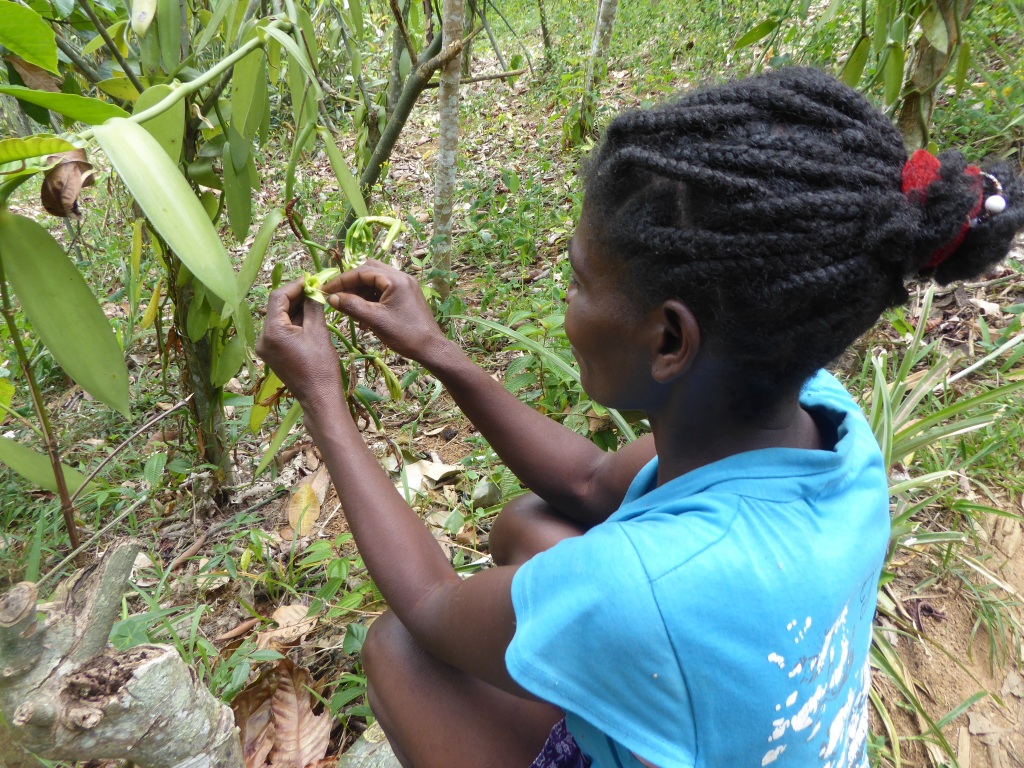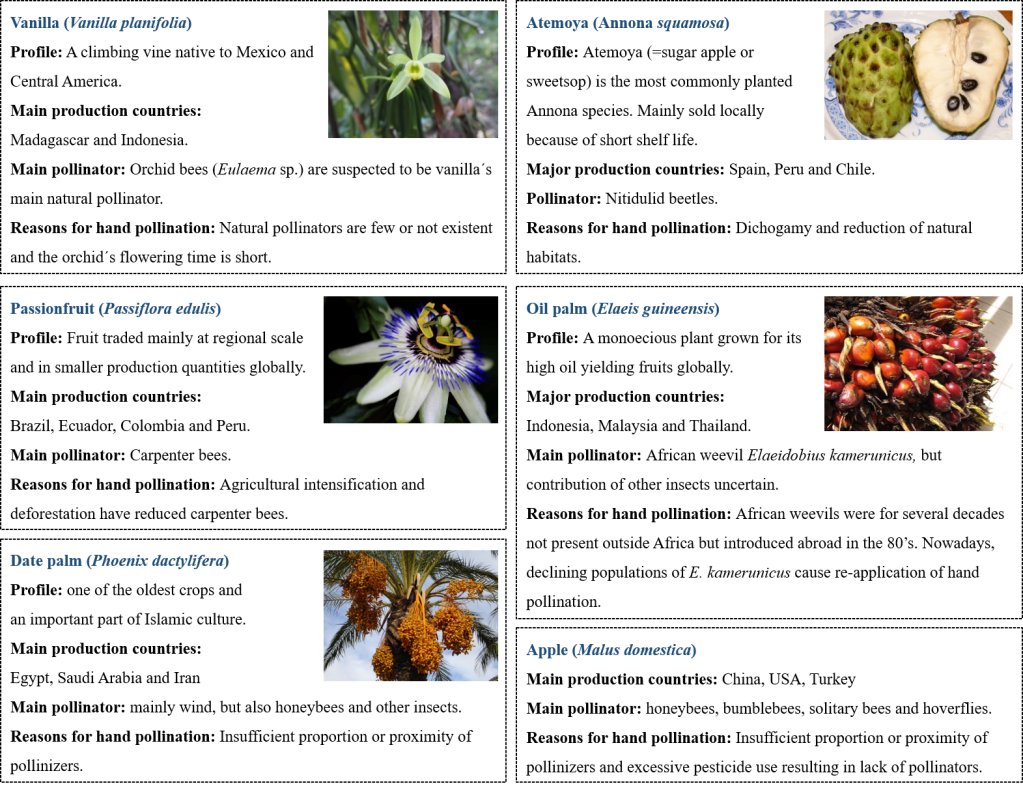In recent years, the cultivation of crops that depend on pollinators has increased worldwide. In addition, there is a severe and large-scale decline of natural pollinators due to agricultural intensification. When natural pollinators are absent, alternative management solutions are needed to ensure sufficient pollination of pollinator-dependent crops such as apple or cacao.

Photo: Annemarie Wurz
Hand pollination is usually performed as an agronomic intervention when pollination is limited. Pollination limiting occurs when pollen quality or quantity is insufficient to pollinate the crop, or pollination fails altogether. Despite the socioeconomic potential of hand pollination in agricultural production, little is known about its prevalence, current importance, or prospects.
In this article, we present for which crop hand pollination is used and identify the reasons for hand pollination. We also address the risks and opportunities of hand pollination.
What is hand pollination?
Hand pollination is a form of pollination in which pollen is applied manually or mechanically to the pistils of the flower. Hand pollination can be exclusive where there is no natural pollination (e.g. vanilla in Madagascar) or supplementary, i.e. pollen is applied in addition to natural pollination (e.g. passionfruit).
Which crops are pollinated by hand worldwide?
Our literature review revealed that hand pollination is used for 20 different crops. These include crops like apple, cacao, date palm, oil palm, pumpkin, tomato, watermelon, atemoya, cherimoya, kiwifruit, passion fruit, pistachio, pitaya and vanilla.
What are the reasons for using hand pollination?
The main reason for using hand pollination is the lack of pollinators. Worldwide we have a decrease of natural pollinators (incl. insects, mammals, birds) mainly due to the intensification of agriculture. For example, the excessive use of pesticides and loss of natural habitat (hedgerow structures, forest, flowering meadows) can decimate pollinators.
Especially, crops that are pollinated by only one pollinator are vulnerable to pollination limitations. For example, atemoya (sugar apple) and cherimoya (custard apple) are exclusively pollinated by nitidulid beetles. Less rainfall and a monotonous agricultural landscape with greater distance to forests reduce the number of nitidulid beetles visiting the orchards.
Crops grown outside their natural range (e.g. vanilla in Madagascar and oil palm in Indonesia) are hand pollinated due to the lack of natural pollinators in the growing area.
Another important reason is the lack or wrong placement of pollinator plants. Many fruit tree varieties of apple and pear are self-incompatible and require cross-pollination from other compatible varieties called pollinizer trees. Pollinizer trees can either be planted in the surrounding area or grafted onto the main crop species. However, low market prices for the fruits of pollinizer trees resulted in a reduction of pollinator trees.
Rising global temperatures, extreme weather events (e.g., heavy rain, wind, or temperature extremes) and bad weather (rainy, cold, cloudy, or windy) can also limit pollination. Here, the activity of natural pollinators may no longer match the plant’s flowering date. Globally, such mismatches are expected to increase because of climate change. For example, climate change has been predicted to alter the range of occurrence of the pollinating carpenter bees in Central America.

Photo: Manuel Toledo-Hernández
The low efficiency of honeybees may also condition hand pollination. In general, domesticated honeybees (Apis mellifera) are increasingly used to compensate for the lack of wild pollinators. However, even when honeybees are available, their pollination performance can be unreliable and low compared to wild insects that pollinate more efficiently. For example, in kiwifruit, bumblebees can transfer more pollen per visit compared to honeybees. Also, in passionfruit and pitayas, honeybees were less suitable pollinators compared to carpenter bees because their bodies are not adapted to the flower morphology and they only visit flowers for a short time.
How is hand pollination performed?
Hand pollination techniques vary, with most being done manually or mechanically (with automated equipment). Examples of manual hand pollination include the application of pollen with a brush, a buffer, a hand sprayer, or simply a male flower brought into contact with the pistils. Increasingly, high-tech devices are being developed, such as pollen spray systems (e.g., for kiwifruit), electrostatic pollen applicators (e.g., for almonds, dates, pistachios, kiwifruit), air blaster (e.g., date palms), electric vibrators (e.g., tomatoes), and even aircrafts (e.g., date palm).
Why does hand pollination perform better than natural pollination?
The improvement in fruit set and fruit quality from hand pollination can be attributed to several factors. Natural pollinators usually carry a mixture of self and cross pollen to the flowers, unlike hand pollination, which uses only cross pollen. Therefore, pollination and pollen competition with low-quality pollen can be controlled for in hand pollination. In addition, animal pollination depends on environmental conditions such as suitable habitat, light intensity, and weather conditions.
What are the benefits and risks of hand pollination?
Hand pollination in commercial production can reduce or prevent monetary losses, making it an attractive and profitable method. Hand pollination allows farmers to ensure consistent yields, control over- or under-pollination, change the frequency of pollination events, decide on the source of pollen, and the optimal timing for pollination and thus harvest, all of which can lead to more consistent and higher incomes. Quality standards such as shape, size, or juice content are critical to high market value and can be optimized for certain crops through manual pollination.
For both small and large farming systems, there are risks and limitations to conducting hand pollination. Overall, hand pollination is time-consuming and labor-intensive because it involves several steps, including harvesting, drying, storing, testing, and spreading pollen. Especially in large-scale systems, the investment in more labor and materials is likely to be too costly if higher yields are not achieved. Therefore, calculating the additional costs from hand pollination (labor, materials, time) versus the benefits received is critical before implementing hand pollination on a large scale. Here, the costs and gains of hand pollination depend on the cropping system and hand pollination techniques. In general, crop production with hand pollination is limited to countries where cheap labor is available and often there are few health and safety standards for workers.
Hand pollination requires specific skills of the human pollinator, depending on the plant species. Fine motor skills are required for pollination of the fragile orchid flowers of vanilla, which is predominantly done by women and children. For cacao, good eyesight is required for hand pollination because the flowers are tiny. If hand pollination is done poorly, the application of pollen can mechanically damage the stigmas of the flowers. In contrast, for crops such as apple or pear, human pollinators require strong physical ability to work in the canopy. Unfortunately, injuries are common in tree pollination. Here, automated systems can provide opportunities to reduce accidents, reduce human labor, and optimize pollination success.
What are our recommendations for hand pollination in agricultural production?
In all systems, the feasibility of hand-pollination depends on the benefits obtained, the costs required, and the resources available in the cropping system. If automated techniques are not available, hand pollination is often carried out by poorly paid workers and even children in precarious conditions. Therefore, hand pollination must be accompanied by social-ecological standards that include protection of pollinators and safe and fair labor. Therefore, crop production should firstly aim to conserve natural pollinators, as natural pollinators are superior to human pollinators in efficiency, speed, and affordability (exceptions exist when natural pollinators are unavailable or recoverable, e.g., vanilla production in Madagascar). If this is not possible, alternative options such as hand pollination can be used.

Photo references:
Vanilla: Annemarie Wurz
Passionfruit: Deasey, J. (2018). This Is A Passionfruit Flower via Wikimedia Commons. Retrieved fromhttps://creativecommons.org/licenses/by-sa/4.0
Oil palm: Naliaka, T. K. (2016). Elaeis guineensis – noix de palme -oil palm fruit via Wikimedia Commons. Retrieved fromhttps://creativecommons.org/licenses/by-sa/4.0
Atemoya: Takoradee. (2007). Annona atemoya via Wikimedia commons. Retrieved from http://creativecommons.org/licenses/by-sa/3.0/
Date palm: Simon. https://pixabay.com/de/photos/dattelpalme-palme-datteln-223251/
For more information about the study follow the link to read the press release „Hand pollination of crops is of major importance“ or read the original publication:
Wurz, A., Grass, I., & Tscharntke, T. (2021). Hand pollination of global crops – a systematic review. Basic and Applied Ecology. Doi: https://doi.org/10.1016/j.baae.2021.08.008

